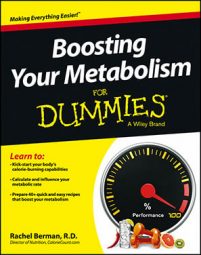No matter where you store fat, you can rev up your burning furnace with activity. Consistent activity — especially weight-bearing, resistance exercises during which you build and tone muscle — can help offset the 5–10 percent in muscle mass decline per decade of life. That’s one of the reasons your metabolism slows as you age.
So you can give yourself a little wiggle room with your daily calorie intake by burning off more through exercise and building lean muscle mass.
Burn fat while exercising
Your body is always using both fat and carbohydrate for energy, just in different ratios, depending on the type and intensity of exercise you’re doing.
The intensity of your exercise is defined by how fast your heart is beating and at what percentage of your maximum heart rate. Your maximum heart rate equals 220 minus your age in years. For example, if you’re 50 years old, your maximum heart rate is 170 beats per minute.
Many exercise machines can monitor your heart rate through sensors that you touch. Otherwise, to determine what level of exercise you’re at, you can take your heart rate manually. Stop briefly during your workout and take your pulse using the tips of your index and middle fingers on your wrist. Count how many beats you feel for 30 seconds and multiply by 2 to get your beats per minute.
Here are the levels of exercise:
Couch potato: While you’re sitting there reading this book, your body is burning calories off at a ratio of about 50 percent carbohydrate and 50 percent fat.
Quick burst: If you sat up and started sprinting, the carbohydrate percentage would go up, because it’s more easily broken down and accessible to muscles.
This type of quick-burst exercise, lasting up to about two minutes, is also known as anaerobic exercise, meaning your body doesn’t use as much oxygen to perform it as it would for more prolonged activity. Anaerobic exercise produces lactic acid, a compound that can build up in the blood and cause fatigue.
Over time, you become more and more able to tolerate this lactic acid, which prolongs the time before your muscles tire, improving your endurance. After exercise, your body needs to take in more oxygen to break down this lactic acid, burning calories after the act.
Moderate intensity: Over time, when you’re engaging in moderate-intensity exercise, like walking briskly, you’re in “fat-burning” mode. A higher percentage of calories that you burn are from fat because your body isn’t working too hard, so it has the resources to break down fat, which is harder to access. In this mode, your heart rate is about 50–70 percent of your maximum rate.
High intensity: When your heart rate hits 70–85 percent of your maximum, your body goes back to using more carbohydrates because it needs the energy more rapidly.
Maybe it’s surprising to you that your body is burning a higher percentage calories from fat at a lower intensity, but that doesn’t translate into more fat calories burned overall. Athletes aren’t lean because they focus on the percentage of time they’re in the fat-burning zone. They’re lean because they work out harder and longer and burn more calories overall.
| Activity (30 min) | Total Calories Burned | Fat Percentage | Fat Calories Burned |
|---|---|---|---|
| Reading | 45 | 50 | 22.5 |
| Walking (3.0 m.p.h.) | 160 | 65 | 104 |
| Running (7.5 m.p.h.) | 450 | 40 | 180 |
* Based on a person who weighs 160 pounds
Your best friend, the afterburn
Although the fat-burning zone during exercise is somewhat of a misnomer, the idea of an afterburn is very real. When you’re exercising, your body is working hard to do a variety of tasks at once, and when you stop, your body then goes through a process to normalize itself.
This normalization is also known as excess post-exercise oxygen consumption, or EPOC. The longer and more intense the activity, the more oxygen your body takes up to replenish your cells. This translates into more calories burned throughout the day and a boosted metabolic rate.
A study published in Medicine and Science in Sports and Exercise found that 45 minutes of vigorous cycling exercise increased metabolic rate for up to 14 hours post workout. The young men in the study burned about 190 calories more during the rest of the day — not including calories burned during exercise.
The effect is also seen with short bouts of resistance exercise; one study found that this can keep the afterburn going for up to 48 hours later!
The amount of calories you can actually burn will vary significantly depending on length of exercise, your body composition, age, and even outdoor temperature. But the highest post-exercise calorie burn occurs when your heart rate is within the zone of 70–85 percent of your max.
If you’re not measuring your heart rate, vigorous-intensity activity with a max after burn means the following:
At minimum, it’s ten minutes long.
You’re short of breath and can only speak a few words at a time — also known as the talk test (with moderately intense exercise, you’re able to talk but not sing).
You’re probably sweating.
You’re jogging, running, swimming laps, cycling more than 10 miles per hour, hiking uphill, speed walking, or playing sports with lots of running like soccer, singles tennis, or basketball.
The longer and more frequently you do these activities, the better. But you also need to be aware of another kind of burn: burning out. It may not be realistic for you to do an hour per day, and that’s okay.
If you know you can’t do high- or even moderate-intensity exercise due to an injury or weakness, you can still reap the benefits of additional calories burned by doing low-intensity exercise like walking or leisurely swimming. Just tack on more time to your workout to maximize how much you can burn.

